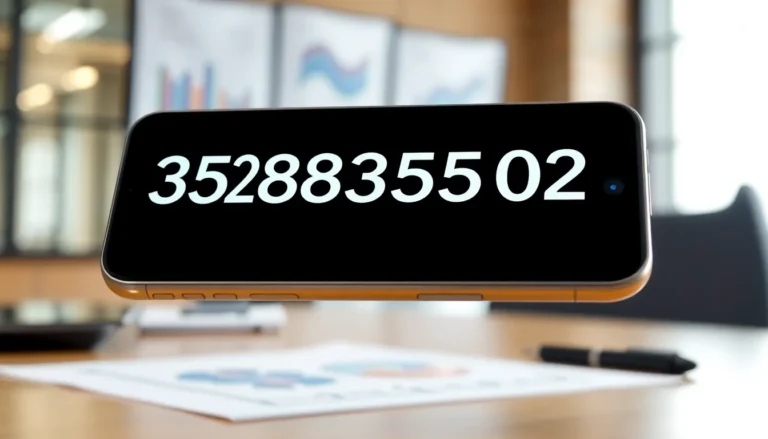In a world overflowing with digital documents and handwritten notes, the struggle to convert text into editable formats can feel like a scavenger hunt without a map. Enter OCR with AI—your trusty sidekick in the quest for efficiency. This technology transforms the tedious task of text recognition into a smooth and almost magical experience.
Table of Contents
ToggleOverview of OCR with AI
OCR, or Optical Character Recognition, transforms images containing printed or handwritten text into machine-readable text. Modern implementations leverage AI to enhance accuracy and efficiency. With AI, systems learn from vast datasets, improving recognition over time.
Artificial intelligence identifies patterns and context that traditional OCR may miss. This capability reduces errors, especially with difficult handwriting or diverse fonts. Intelligent OCR solutions employ machine learning models to correctly interpret irregularities and variations in text.
Various applications demonstrate the power of OCR with AI. For example, businesses streamline document processing by converting invoices into digital formats for easy management. Additionally, educational institutions digitize lecture notes, making them accessible and searchable.
AI-powered OCR integrates features such as automatic language detection and character confidence scoring. It analyzes characters and predicts the likelihood of accuracy based on contextual data. Enhanced algorithms ensure improved performance in challenging scenarios, providing seamless user experiences.
A variety of industries harness OCR with AI. Healthcare professionals document patient records, while legal teams process contracts efficiently. Significant time savings and increased productivity result from these implementations.
Investing in AI-driven OCR technology can lead to substantial operational improvements. Businesses seeking enhanced text recognition capabilities find that AI solutions significantly outperform traditional methods. Overall, OCR with AI represents a powerful tool for transforming how organizations handle text, facilitating accuracy and efficiency.
How OCR with AI Works
OCR with AI transforms printed and handwritten text into editable formats using advanced algorithms. This technology optimizes accuracy and efficiency in text recognition.
Machine Learning Techniques
Machine learning techniques form the backbone of AI-enhanced OCR systems. These systems analyze large datasets to recognize patterns in text, improving recognition over time. Supervised learning trains models with labeled examples, such as images containing text paired with their correct output. Unsupervised learning aids in identifying patterns without explicit labels, enhancing adaptability. Deep learning, a subset of machine learning, employs neural networks to capture complex relationships in text data. The combination of these techniques leads to reduced errors, especially in challenging handwriting or unique fonts. Ultimately, machine learning empowers OCR technology to deliver more precise and reliable results.
Natural Language Processing Integration
Natural Language Processing (NLP) plays a crucial role in augmenting OCR capabilities. By integrating NLP, these systems gain an understanding of contextual language and syntax. This context helps improve interpretation, disambiguating words that may appear similar. Sentiment analysis can identify the tone of the text, informing users of nuances. Additionally, NLP enables automatic language detection, making the technology versatile in multilingual environments. Character confidence scoring uses NLP to assess how accurately text is recognized, guiding users on potential inaccuracies. Together, these features enhance the efficiency of OCR applications across various industries.
Applications of OCR with AI
OCR with AI serves diverse applications across various sectors. Delving into its utility reveals significant advantages.
Document Digitization
Document digitization benefits immensely from OCR with AI. Businesses transform paper documents into searchable digital formats, enhancing accessibility. Employees find retrieving information in electronic systems much easier than sifting through physical files. In educational settings, digitized notes allow students to search for specific content rapidly. Organizations improve workflow efficiency by minimizing physical storage needs and enabling remote access to archived materials.
Data Extraction and Processing
Data extraction and processing showcase another vital application of AI-powered OCR. Financial institutions automate invoice processing, reducing manual entry errors. Automated systems extract key information, such as dates and total amounts, resulting in time savings. Healthcare organizations utilize OCR to extract patient data from forms accurately. Swift processing of large volumes of paperwork enhances overall productivity and ensures data accuracy.
Automated Customer Service
Automated customer service leverages OCR technology to enhance user experiences. Companies deploy chatbots that access and interpret information from documents seamlessly. Customers experience quicker response times when automated systems pull relevant data automatically. Service agents benefit from reduced workloads as OCR systems handle basic inquiry resolutions, allowing staff to focus on complex issues. Enhanced efficiency in customer interactions leads to increased satisfaction and loyalty.
Advantages of OCR with AI
OCR powered by AI offers numerous advantages that enhance text recognition capabilities significantly. Increased accuracy and cost efficiency are two of the primary benefits organizations experience.
Increased Accuracy
AI-driven OCR systems reduce error rates in text recognition. They leverage extensive datasets, allowing algorithms to learn and identify subtle patterns in handwriting and various fonts. Enhanced contextual understanding means minor inaccuracies find fewer places to occur. Training on diverse examples helps these systems adapt to unique writing styles. Results show improved performance, especially with challenging documents. Many industries benefit from this accuracy boost, leading to more reliable outcomes.
Cost Efficiency
Implementing AI-enabled OCR solutions leads to substantial cost savings for organizations. Automating the digitization process eliminates the need for manual data entry, reducing labor costs significantly. Fast processing speeds mean tasks that once took hours can now finish within minutes. Resource allocation improves as employees focus on higher-value tasks instead of tedious ones. Overall productivity increases across sectors, enhancing efficiency without stretching budgets. Investments in these technologies often yield a positive return by streamlining operations.
Challenges and Limitations
OCR systems powered by AI face several challenges that affect their effectiveness and deployment.
Data Privacy Concerns
Data privacy remains a critical issue in AI-driven OCR applications. Sensitive information from documents can be exposed during the digitization process, increasing the risk of data breaches. Organizations often handle personal data, which requires compliance with regulations like GDPR and HIPAA. Ensuring data is stored and processed securely is essential to protect user privacy. Companies must implement robust encryption methods and access controls to safeguard the information. Transparency about data collection and usage also builds trust with users. Failure to address these concerns may result in legal repercussions and damage to an organization’s reputation.
Quality of Input Data
Input data quality significantly impacts the performance of AI-powered OCR systems. Poorly scanned documents, low-resolution images, and unclear handwriting can lead to misinterpretation and errors in text recognition. Variability in font types and sizes also complicates accurate recognition. Implementing quality control measures during the data capture process helps mitigate these issues. Cleaning and preprocessing input data before recognition improves overall outcomes. Regular updates to training datasets ensure the system adapts to new styles and patterns encountered in diverse documents. Ensuring high-quality input directly influences the reliability of OCR outputs.
Conclusion
OCR with AI represents a significant leap forward in text recognition technology. By harnessing advanced algorithms and machine learning techniques, it addresses the challenges of converting both printed and handwritten text into editable formats. The integration of AI not only enhances accuracy but also streamlines workflows across various industries.
As organizations continue to adopt these solutions, they can expect improved efficiency and productivity. However, it’s crucial to remain vigilant about data privacy and the quality of input data to maximize the benefits of OCR technology. Embracing these advancements will empower businesses and institutions to operate more effectively in an increasingly digital world.






